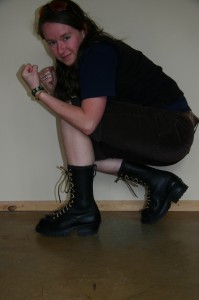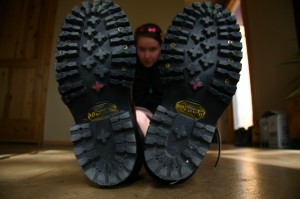
White's 10-inch, lace-to-toe Smokejumpers, men's size 5.
Welcome to the new Susan. From hippie world traveler to burly, smoke-breathing firefighter. Instead of hugging trees, now I’m wishing they’d catch on fire so I could save them and start getting some of that legendary overtime and hazard pay. It’s not a natural transition; it’s taken training and various other components.
Start with $453 boots.

White's Smokejumpers - BEFORE fire season.
White’s Smokejumpers: ten inches tall, handmade, leather, Vibram® soles secured with fireproof thread and steel screws, reinforced toes and logger’s heels. They’re tough to break in, and not only for the hard leather and hard foot beds that wear red puffy blisters into sensitive heels and arches. I wore my new boots to my first day of chainsaw training. The six foot lumberjacks who taught saw school peered down their impressive beards and indicated my shiny, clean White’s with a twitch of the chin or elbow. “This must be your first year,” one said, his eyes raised appraisingly to my face. “Oh, well…” I looked down and saw their battered, scarred boots next to mine. “What gave me away?”
It was a relief, during our field testing day, to scuff my boots in the dirt and fill the eyelets with sawdust as I felled my first two trees. Armed with a 28” Stihl 044 saw, thick green chaps, a felling axe and a pouch of wedges, I strode up the hill behind my tester. My legs felt heavy; I had to lengthen my stride and step purposefully, balancing the 25-lb. chainsaw on my shoulder. I dropped two trees, two bug-killed pines. My arms shook as I finished the back cut on the last tree and stepped away, watching it land right where I’d placed it. Tired but thrilled, I caught a glimpse of my shadow as we came out of the trees and crossed the road back to the trucks. It looked like a firefighter’s shadow.
Add Nomex®: the forest green and sunshine yellow fire-resistant uniform of the wildland firefighter. The pants are stiff and the cargo pockets make them heavy, loaded as they are with ear plugs, lighter (every good firefighter knows how to start a fire as well as put it out), Leatherman (or comparable pocket tool), pen, notepad, Smokey calendar (for documenting hours worked and tasks completed), and the indispensible IRPG (Incident Response Pocket Guide – required, abbreviated “how-to” for every imaginable fire scenario). I also wear my gloves on a carabiner at my belt, and, because I work on an engine, I carry a spanner wrench for tightening hose fittings.
There are several types of firefighting resources in the employ of the federal government. Initial attack (IA) squads respond to a fire when it’s first spotted, typically when it’s a single tree that’s been hit by lightning and can still be handled by six people with shovels and a chainsaw. Hand crews fight fire the same way that the IA squads do, using tools and saws to cut miles of line – a wide swath of mountainside cut and scraped down to mineral soil – in an attempt to stop the fire from advancing in a certain direction. Every fire fighter will work on a hand crew at some point in his or her career, whether it’s an initial attack effort or while fighting a 50,000 acre fire in conjunction with other resources. Helicopters and air tankers are expensive but essential tools that can quickly drop hundreds of gallons of water or retardant on large fires, as well as transport ground crew and supplies to remote edges of a fire. Finally, there are fire engines, smaller, modified versions of the shiny red pavement queens that deal with structure fires in cities and towns across the US. I work on Engine 411 in Salt Lake City, serving the Uinta-Wasatch-Cache (yoo-IN-tah) National Forest. There are seven people on my crew. Shane is our engine boss and Watson’s our lead; between the two of them they have close to twenty years of firefighting experience. Graham (25), Brock (21), and Tomas (23) have worked on the engine for 2-4 years each. I’m the new person, the FNG, and so is Maren, the only other woman on the team: a 19-year-old, blond, French student from Brigham Young University. I like my crew. I like rolling around in our engine and unloading at a gas station or campground and moving like black-booted posse through the parking lot.
Stir in some required training. In six weeks I’ve been paid to attend chainsaw school, fire school, resource management school, map-reading class, radio class, SOP class, pump school, driving school, sensitivity-and-political-correctness class, first aid and CPR class, rules-and-regulations class, and ATV school. Fire school was a week long. Lessons ran the gamut from the sleep-inducing: “Chain of Command”; to the confusing: “Programming Radios”; the fascinating: “Weather and Fire Behavior”; and the terrifying: “How and When to Deploy Your Fire Shelter”. The latter involved an hour of video footage of walls of flame against night skies, shots of mangled trees choked with smoke, and a somber narrator’s voice describing how Firefighter X’s series of errors led to his hellish demise. After being properly scared into paying attention, we were led outside as a class and given practice shelters made of green nylon. We took turns being timed, shaking out the fabric, wrapping ourselves up, rolling around on the green lawn. It was about 65 degrees, partly cloudy, and extremely difficult to imagine someday facing a 6,000 degree flame front with only a bottle of water and a sheet of aluminum foil to keep me alive.
Today’s June 21. It’s pouring rain. As of a week ago, Utah had received 120% of its average rainfall for June. The mountainsides are a patchwork quilt of saturated green leaves and fat grasses. White clouds hang around the peaks like pillows. Nothing’s burning. There’s lightning every day, but the rain douses it immediately. Anything it strikes sucks up the scorching energy and carries on being wet and happy. The government, however, pays me to be on duty forty hours a week, and as there are no fires, the crew’s got to do something to keep busy. This means classes. It also means sharpening tools, washing hose, building hose packs, and lots of thumb-twiddling.
Pour on copious amounts of exercise. We train as a crew, at the gym if it’s raining, hiking if it’s not. When we hike we dress in full fire gear, hardhats, long sleeves and all, carrying our 30lbs of required personal gear plus a tool (shovel, rhino, Pulaski, combi) or a chainsaw or a can of gas for the saw. We carry radios and practice passing messages from the head of the line to the back, and we go as fast as we can as far as we can until we can’t. Then we do pushups, wall-sits, lunges, and crunches. Marching as we do in a line, in bright yellow shirts and blue hardhats, we draw attention on the trails. One day we paused for a water break on a rock outcrop halfway up Mt. Olympus. The sound of spinning rotors suddenly drowned out our conversation as the Channel 4 news-copter appeared above us and zeroed in, its nose camera swiveling to catch us in action. We waved and grinned and shook our heads.
The hikes are hard, even for me. And it’s only going to get harder. And hotter. Training, gear, and instruction aside, I’ve been told again and again that I won’t get it until I actually see a fire and smell the smoke and feel what it’s like to dig line for sixteen hours straight. I’m missing that one crucial ingredient, and it’s going to have to stop raining before that happens. In the meantime, I listen to the stories of my crew, absorb the advice of the lumberjacks and the other experts, explore my national forest, and look forward to that first spark.
Susan, this is awesome! You totally captured what we do and what this job is like. If I ever have anyone ask me exactly what my job consists of, I’m going to refer them to this.
This really makes me want to become a firefighter.. not really.
Waaay too much back breaking work! Good for you though!
Susan, the badass hippie firefighter! You can use that as the title for your new book if you want, as long as I get 0.00001% of the royalties. It’s a great introduction you have here. Cool boots you have there too — you look ready to stomp those fires out!
Hey Susan –
My cousin did smoke jumping for some wildlife service somewhere in Colorado or something. You two could be friends!
– Bryan